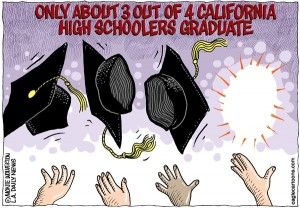USA No. 1 in education — spending
By Larry Sand
The National Education Association, whose state affiliate is the California Teachers Association, just came out with a “research” report which should be taken about as seriously as the Tobacco Institute study that denied the link between smoking and lung cancer. The “Rankings of the States 2012 and Estimates of School Statistics 2013” report is filled with half-truths and worse. The summary tells us that education is hurting in America and the problems revolve around the fact that we don’t spend enough. We are led to believe that per-student spending is insufficient, we don’t pay our teachers enough, and class sizes are too big.
But then, lo and behold, we get a real study from the Organisation for Economic Co-operation and Development, which historically has supplied us with objective international comparisons. Released last week, their latest, a 440 page tome, is filled with statistics that lay to waste much of the NEA’s tired plea for more spending on education.
From an Associated Press summary of the report, we learn:
“The United States spent more than $11,000 per elementary student in 2010 and more than $12,000 per high school student. When researchers factored in the cost for programs after high school education such as college or vocational training, the United States spent $15,171 on each young person in the system—more than any other nation covered in the report.
“That sum inched past some developed countries and far surpassed others. Switzerland’s total spending per student was $14,922 while Mexico averaged $2,993 in 2010. The average OECD nation spent $9,313 per young person.” (Emphasis added.)
Ranking
According to NEA’s way of thinking, being the top spender should result in the U.S. producing the best students, but this is not the case. In fact, far from it. AP continued:
“U.S. fourth-graders are 11th in the world in math in the Trends in International Mathematics and Science Study, a separate measure of nations against each other. U.S. eighth-graders ranked ninth in math, according to those 2011 results.
“The Program for International Student Assessment measurement found the United States ranked 31st in math literacy among 15-year-old students and below the international average. The same 2009 tests found the United States ranked 23rd in science among the same students, but posting an average score.”
What about teacher salaries?
The OECD report found:
“The average first-year high school teacher in the United States earns about $38,000. OECD nations pay their comparable educators just more than $31,000.
“That trails Luxembourg, which pays its first year teachers more than $72,000 a year, but far exceeds the $10,000 paid to first-year high school teachers in Slovakia. Among all educators, U.S. payrolls are competitive. The average high school teacher in the United States earns about $53,000, well above the average of $45,500 among all OECD nations.”
And of course, the countries with the smallest class sizes are the most successful, right?
Well, no. There is absolutely no correlation. For example, countries with about 30 students per elementary school class — Chile, Japan, Israel and Korea — do better than we do with about 20 kids per class when it comes to students completing an upper secondary education.
Spending
Via Choice Media, Paul Peterson, Director of the Program on Education Policy and Government at Harvard University, states the obvious:
“We do not spend our money wisely. We don’t have a very competitive system. Anytime a monopoly spends money, and our education system is a monopoly, it is not spending money efficiently. We don’t hire our teachers the right way. We don’t pay the best teachers more money and we don’t get rid of our weakest teachers because we pay everybody the same rate except for their credentials and their years of experience. We don’t have a way of easing the weakest members of the teaching force out of the profession.”
Larry Sand, a former classroom teacher, is the president of the non-profit California Teachers Empowerment Network – a non-partisan, non-political group dedicated to providing teachers with reliable and balanced information about professional affiliations and positions on educational issues.
Related Articles
UC tuition battle sparks student protests
The battle over University of California tuition hikes has been raised to a new level — with shades of 1960s student
Feds Quash Non-Profit Student Loan Money
AUG. 3, 2010 By EVELYN STACEY On July 30 the U.S. Department of Education quashed California’s plan to sell EdFund,
State Community College accreditor determined unfit after five decades
In deciding last week to remove the body that accredits community colleges in California, state commissioners erased five decades of





